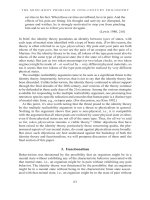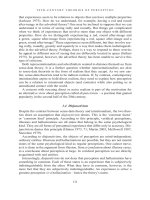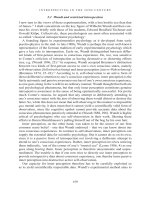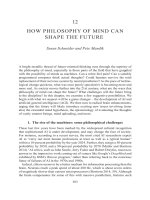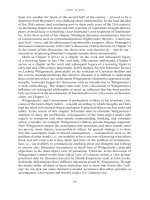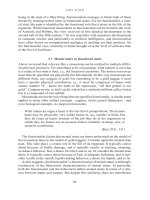Philosophy of mind in the twentieth and twenty first centuries the history of the philosophy of mind volume 6 ( PDFDrive ) (1) 34
Bạn đang xem bản rút gọn của tài liệu. Xem và tải ngay bản đầy đủ của tài liệu tại đây (138.89 KB, 1 trang )
INTRODUCTION TO VOLUME 6
If events can be causally related only if there are laws that cover them, then the
absence of psychological or psychophysical laws raises doubts about mental
events’ causal efficacy.
An explosion of interest in mental causation as the result of discussion of the
Anomalism Problem in turn led to two other problems of mental causation. The
Exclusion Problem, owing to the work of Jaegwon Kim, questions how mental
events can be causally efficacious given the causal closure of the physical domain.
Given causal closure, every event or action has a fully sufficient physical cause
that “excludes” other causes, such as mental causes, in bringing about the action.
The other problem arises from worries about externalism. According to content
externalism (see the extensive discussion in Chapter 10), representational states
are not solely “in the head.” Rather, their content depends on social and environmental factors. But if this is true, then unless we are prepared to accept some kind
of spooky action at a distance, mental contents do not look like they play a role in
causing behavior. As Yoo discusses, the last decades of the 20th century witnessed
careful attention to all three of these problems.
In Chapter Eight, Michelle Montague takes up the notion of intentionality, i.e.,
the respect in which our mental states are object-directed. Her discussion focuses
on Franz Brentano, a philosopher whose work has been enormously influential
in 20th- and 21st-century theorizing about the topic. Brentano’s work aimed to
establish two central claims about intentionality. First, he claimed that intentionality is the “mark” of the mental, i.e., that all and only mental states are intentional. Second, he claimed that consciousness and intentionality are constitutively
related to one another. While much of 20th-century discussion of intentionality
was preoccupied with what’s often referred to as the problem of intentionality –
the problem of how we can think about nonexistent objects – Montague argues
that a focus on this problem obscures our understanding of Brentano’s position
and leads to misinterpretations of it.
Montague begins with a detailed explication of Brentano’s theories of consciousness and intentionality in his Psychology from an Empirical Standpoint,
published in 1874. She then discusses the shift in his views evident in the publication of the 1911 Appendix to this work. As Montague shows, Brentano moves
from thinking about intentionality as involving reference to something as object to
thinking of it explicitly as a relation. Her discussion then moves to other philosophers who were influenced by Brentano, and she shows the impact that his work
has had on subsequent philosophical discussions of intentionality. She starts with
Kazimierz Twardowski and Alexius Meinong, two students of Brentano’s who
attempted to develop and improve upon their teacher’s original theory. She then
turns to Roderick Chisholm, the philosopher largely responsible for generating
interest in Brentano’s work within contemporary analytic philosophy. Chisholm’s
focus on our apparent ability to think about nonexistent objects set the terms for
much of the subsequent discussion about intentionality in the second half of the
20th century. Montague argues that much of that discussion – and in particular, the
separatist assumptions that treated intentionality and consciousness in isolation
15

